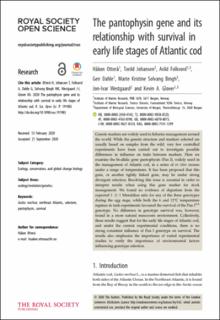| dc.description.abstract | Genetic markers are widely used in fisheries management around the world. While the genetic structure and markers selected are usually based on samples from the wild, very few controlled experiments have been carried out to investigate possible differences in influence on traits between markers. Here we examine the bi-allelic gene pantophysin (Pan I), widely used in the management of Atlantic cod, in a series of in vitro crosses under a range of temperatures. It has been proposed that this gene, or another tightly linked gene, may be under strong divergent selection. Resolving this issue is essential in order to interpret results when using this gene marker for stock management. We found no evidence of departure from the expected 1 : 2 : 1 Mendelian ratio for any of the three genotypes during the egg stage, while both the 6 and 12°C temperature regimes in tank experiments favoured the survival of the Pan IAA genotype. No difference in genotype survival was, however, found in a more natural mesocosm environment. Collectively, these results suggest that for the early life stages of Atlantic cod, and under the current experimental conditions, there is no strong consistent influence of Pan I genotype on survival. The results also emphasize the importance of varied experimental studies to verify the importance of environmental factors influencing genotype selection. | en_US |
